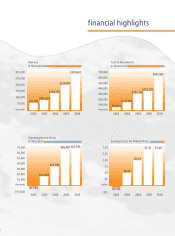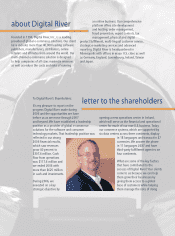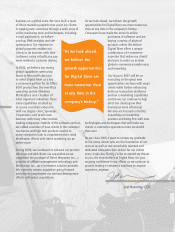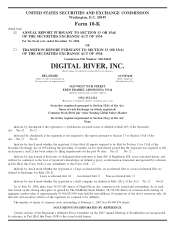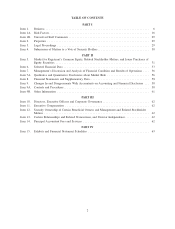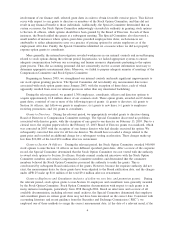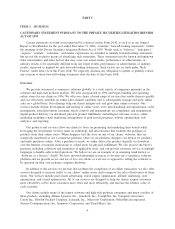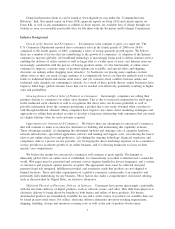Digital River 2006 Annual Report Download - page 11
Download and view the complete annual report
Please find page 11 of the 2006 Digital River annual report below. You can navigate through the pages in the report by either clicking on the pages listed below, or by using the keyword search tool below to find specific information within the annual report.General information about us can be found at www.digitalriver.com under the “Company/Investor
Relations” link. Our annual report on Form 10-K, quarterly reports on Form 10-Q and current reports on
Form 8-K, as well as any amendments or exhibits to those reports, are available free of charge through our
website as soon as reasonably practicable after we file them with the Securities and Exchange Commission.
Industry Background
Growth of the Internet and E-Commerce. E-Commerce sales continue to grow at a rapid rate. The
U.S. Commerce Department reported that e-commerce sales in the fourth quarter of 2006 rose 24.6%
compared to the fourth quarter of 2005, continuing a series of strong quarterly growth reports. We believe
there are a number of factors that are contributing to the growth of e-commerce: (i) adoption of the Internet
continues to increase globally; (ii) broadband technology is increasingly being used to deliver Internet service
enabling the delivery of richer content as well as larger files to a wider array of users; (iii) Internet users are
increasingly comfortable with the process of buying products online; (iv) the functionality of online stores
continues to improve, a greater range of payment options are available, and special offers and shipping
discounts are making online shopping more attractive; (v) businesses are placing more emphasis on their
online stores as they can reach a larger audience at a comparatively lower cost than the methods used to drive
traffic to traditional bricks-and-mortar retail stores; and (vi) concerns about conflicts between online and
traditional sales channels are continuing to subside. As a result of these growth drivers, online businesses have
begun to build large, global customer bases that can be reached cost-effectively, potentially resulting in higher
sales and profitability.
Growing Interest in Direct Sales of Products to Consumers. Increasingly, companies are selling their
products directly to consumers via online sales channels. This is due to increased competition for shelf space
in the traditional retail channels as well as recognition that direct sales can be more profitable as well as
provides information about the consumer purchasing a product that is not easily obtained when a product is
sold through traditional channels. Many companies have begun to use classic direct marketing techniques and
approaches to selling their products in order to develop a long term relationship with consumers that can result
in a higher lifetime value for each customer acquired.
Opportunities for Outsourced E-Commerce. We believe there are advantages to outsourced e-commerce
that will continue to make it an attractive alternative to building and maintaining this capability in-house.
These advantages include: (i) eliminating the substantial up-front and ongoing costs of computer hardware,
network infrastructure, specialized application software and training and support costs; (ii) reducing the time it
takes to get online stores live and productive; (iii) shifting the ongoing technology, financial, regulatory and
compliance risks to a proven service provider; (iv) leveraging the direct marketing expertise of an e-commerce
service provider to accelerate growth of an online business; and (v) allowing businesses to focus on their
specific core competencies.
We believe the market for outsourced e-commerce will continue to grow rapidly. The Internet is
inherently global. Once an online store is established, it is immediately accessible to Internet users around the
world. Web pages must be presented and customer service inquires handled in diverse languages, and a variety
of currencies and payment options must be accepted. The appropriate taxes must be collected and paid,
payment fraud risk mitigated, fulfillment provided, and assurances made that products are not shipped to
banned locations. These and other requirements of a global e-commerce system make it an expensive and
potentially risky undertaking for any business. These factors also make a comprehensive outsourced offering,
such as that provided by Digital River, an attractive alternative.
Shift from Physical to Electronic Delivery of Software. Consumers have grown increasingly comfortable
with the electronic delivery of digital products, such as software, music, and video. This shift from physical to
electronic delivery is being driven by benefits to both buyers and sellers of these products. For buyers,
downloaded products are immediately available for use and a wider variety of products are available than can
be found in most retail stores. For sellers, electronic delivery eliminates inventory-stocking requirements,
shipping, handling, storage and inventory-carrying costs as well as the risk of product obsolescence.
7


